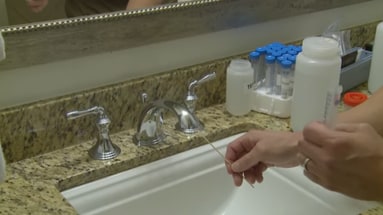Key points
- Environmental sampling establishes the location, extent, and type of Legionella present.
- Environmental sampling is also important for verifying that remediation activities are working.
- Many different factors should go into making and implementing a sampling plan. These recommendations are not all-inclusive.

Overview
Use the environmental assessment, other water system resourcesA, and epidemiologic information to
- Determine whether to conduct Legionella environmental sampling
- Develop a sampling plan
Looking for investigation forms and more?
Objectives of environmental sampling
The objectives of Legionella environmental sampling during an outbreak are to
- Identify potential sources of exposure
- Characterize the extent and location of Legionella colonization within the building water system(s)
- Verifying that remediation activities are working to control the hazard
Factors impacting the sampling plan
Developing a sampling plan is a complex process. These recommendations are not intended to be all-inclusive. In some situations, hiring professionals with specific expertise in sampling for Legionella may be helpful. See these factors to consider when working with Legionella consultants.
Legionella environmental sampling plans during an investigation are unique to each investigation and can be based on many factors such as:
- Findings from the environmental assessment
- Previous sampling results, if available
- Building characteristics (e.g., size, age, complexity, populations served)
- Sites of possible exposure to aerosolized water as determined by the environmental and epidemiologic investigations
- Available sampling supplies and testing capacity
Additional environmental assessment and sampling resources are available.
The sampling procedure guide describes how to obtain both bulk water and biofilm swab samples.
Collection considerations
Some of the considerations for where and how to collect samples include the following:
- Environmental assessment
- Available epidemiologic information
- Trends in water management program performance
Environmental assessment
Individual water systems and devices
When the environmental assessment identifies multiple individual water systems or devices, each should be represented separately in the sampling plan.
If sampling cooling towers, hot tubs, or decorative fountains, collect swab samples of
- The waterline
- Inside jets
- Any visible biofilm
Biofilm swab results can provide information about presence and location of Legionella in biofilm.
Consider sampling filters (e.g., sand, cartridge) if they are present.
Multiple factors should be considered when deciding whether to sample hot versus cold water systems (or both).
Common locations
Consider including locations that are representative of the system as a whole or places where Legionella is likely to grow.
Examples of common locations for sampling may include:
- Near the building water entry
- Water heaters and/or storage tanks
- Representative points-of-use
- Hot water return lines
- Associated devices
Consider including locations where water parameters measured during the environmental assessment indicate risk for Legionella growth and transmission. This allows you to evaluate the potential for amplification/transmission.
Available epidemiologic information
Consider if cases were exposed to particular showerheads, sink faucets, or other fixtures and devices.
Trends in water management program performance
Sometimes, targeted sampling might be used to understand known problem areas in a building water system.
Feasibility
It's also important to consider the time and resource constraints of the group performing the investigation.
Volume
Whenever possible, a collection of one liter of water is preferred. You will occasionally need larger volumes of water (1 to 10 liters) to detect Legionella in water that has very low concentrations of these bacteria, such as municipal water supplies. If you cannot collect a liter from a sample source, a smaller volume may be acceptable.
Ensure that the laboratory processes an appropriate volume for the type of sample collected and the test conducted. For instance, processing a full liter for culture is preferred for potable water, while smaller volumes from samples of nonpotable water sources such as fountains and cooling towers are typically plated directly.
- Numerous water system resources can be used in an investigation. Examples include mechanical drawings (blueprints, schematics, as-builts), hydraulic modeling, corrosion assessments, dye testing, sanitary surveys, and additional water testing results.
- Kozak NA, Lucas CE, Winchell JM. Identification of Legionella in the environment. Methods Mol Biol. 2013;954:3–25.
